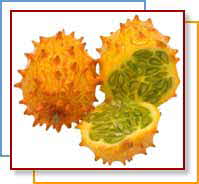Home | FOOD ARTICLES | Food Trivia | Today_in_Food_History | Food_History_Timeline | Recipes | Cooking_Tips | Food_Videos | Food_Quotes | Who’s_Who | Culinary_Schools_&_Tours | Food_Trivia_Quizzes | Food_Poems | Free_Magazines | Food_Festivals_and_Events
Food Articles, News & Features Section
FREE Magazines
and other Publications
Free Professional and Technical Research, White Papers, Case Studies, Magazines, and eBooks
KIWANO MELON
African Horned Melon
Kiwano melon is an oval shaped fruit with horns on its peel. It has a bright orange and yellow skin with a pale yellow-green jelly-like flesh with large seeds. The flavor of the pulp is sweet and a bit tart with a flavor mix of bananas, lime and cucumber. They are actually a fairly bland tasting fruit. 
Kiwano melon is native to southern and central Africa and is commonly known as an African horned melon. Most imported melons are now from New Zealand. California has began growing this melon, so a domestic product is available part of the year.
Commercial production is limited partly because harvesting the fruit is time consuming and labor intensive. Gloves must be warn and care must be taken so neighboring fruits are not punctured with the spines. Kiwanos grow similar to cucumbers and are vigorous hearty climbers and can easily and quickly take over space.
Selection
Select melons without any bruises or spots with a bright orange color. It is best to purchase a melon that has the horns intact, as damaged horns may be a sign of rough handling. Kiwano melons are available year round in specialty markets and supermarkets.
Storage
Unripe melons may be stored at room temperature for up to two weeks. Ripe melons will last about 3 to 4 days at room temperature. There is no need to refrigerate kiwano melon.
RELATED ARTICLES
Please feel free to link to any pages of FoodReference.com from your website.
For permission to use any of this content please E-mail: james@foodreference.com
All contents are copyright © 1990 - 2025 James T. Ehler and www.FoodReference.com unless otherwise noted. All rights reserved.
You may copy and use portions of this website for non-commercial, personal use only.
Any other use of these materials without prior written authorization is not very nice and violates the copyright.
Please take the time to request permission.
